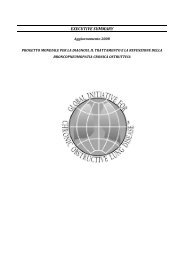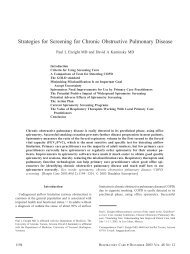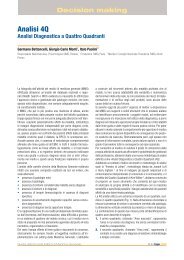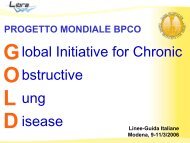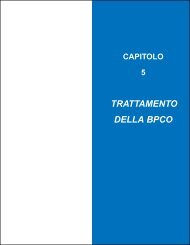COPD phenotypes - GOLD
COPD phenotypes - GOLD
COPD phenotypes - GOLD
Create successful ePaper yourself
Turn your PDF publications into a flip-book with our unique Google optimized e-Paper software.
602 AMERICAN JOURNAL OF RESPIRATORY AND CRITICAL CARE MEDICINE VOL 182 2010<br />
of <strong>COPD</strong> Longitudinally to Identify Predictive Surrogate<br />
Endpoints (ECLIPSE), Subpopulations and intermediate outcome<br />
measures in <strong>COPD</strong> (SPIROMICS), and <strong>COPD</strong>Gene that<br />
are systematically gathering clinical, physiologic, radiologic,<br />
biologic, and genetic data on <strong>COPD</strong> subjects will aid in this<br />
regard. Additionally, advanced statistical techniques may also<br />
prove useful in identifying candidate phenotypic subgroups.<br />
One such example is cluster analysis, which has a basis both in<br />
mathematics and biology and is a technique for data exploration.<br />
Cluster analysis encompasses a number of different<br />
algorithms for grouping subjects without an a priori hypothesis.<br />
A related statistical technique, factor analysis, may also prove<br />
useful in <strong>COPD</strong> phenotyping. Although the goal of cluster<br />
analysis is to reduce the number of observations or cases by<br />
grouping them into a smaller set of clusters, the goal of factor<br />
analysis is to reduce the number of variables by grouping them<br />
into a smaller set of factors. Cluster and factor analysis have<br />
been used in conjunction in <strong>COPD</strong> to identify key variables on<br />
which to select clusters of related patients (60–63). These types<br />
of analyses would still, however, require longitudinal validation<br />
to determine how such clustered subjects differ with respect to<br />
important clinical outcomes. In addition, such analyses may or<br />
may not ultimately be useful in defining specific biologic<br />
pathways or therapies.<br />
The suggested schema for phenotype identification, however,<br />
represents an ideal construct, as almost every outcome measure<br />
other than death displays inherent difficulties with measurement.<br />
Furthermore, for every phenotype, a specific therapy may<br />
not be ultimately identified. An individual’s phenotype may not<br />
be readily apparent at an early stage of disease. It may also be<br />
that any one individual has the potential to express a range of<br />
<strong>phenotypes</strong> that are ultimately determined by the individual’s<br />
unique biology and exposures. Finally, it should be recognized<br />
that most cellular functions (and their perturbations in disease<br />
states) are performed by a complex network of genes, proteins,<br />
and metabolites that interact through biochemical and physical<br />
interactions. The new field of systems biology has begun to<br />
relate these ‘‘omic’’ networks to disease networks (comorbidities)<br />
and even social networks (smoking, obesity). Consequently,<br />
the concept of a ‘‘diseasome,’’ linking cellular networks<br />
and phenotypic manifestations, is beginning to emerge. Such<br />
research strategies may also prove valuable in identifying<br />
relevant and novel <strong>phenotypes</strong> in <strong>COPD</strong>.<br />
Author Disclosure: M.K.H. received up to $1,000 from Novartis in consultancy<br />
fees, $1,001–$5,000 from CSL Behring in advisory board fees, $5,001–$10,000<br />
from GlaxoSmithKline in lecture fees, and up to $1,000 from UpToDate in<br />
royalties. A.A. received $5,001–$10,000 from GlaxoSmithKline, $5,001–$10,000<br />
from Almirall, and $5,001–$10,000 from Nycomed in advisory board fees;<br />
$5,001–$10,000 from GlaxoSmithKline, $5,001–$10,000 from AstraZeneca,<br />
and $5,001–$10,000 from Almirall in lecture fees; and more than $100,001<br />
from GlaxoSmithKline, $10,001–$50,000 from Pfizer, $5,001–$10,000 from<br />
Boehringer Ingelheim, and more than $100,001 from Almirall in industrysponsored<br />
grants. P.M.C. received $5,001–$10,000 from Pfizer, $1,001–<br />
$5,000 from AstraZeneca, and $5,001–$10,000 from Chiesi in consultancy fees;<br />
$5,001–$10,000 from GlaxoSmithKline in advisory board fees; $1,001–$5,000<br />
from Altana and $10,001–$50,000 from GlaxoSmithKline in lecture fees; and<br />
$10,001–$50,000 from Nycomed, $50,001–$100,000 from GlaxoSmithKline,<br />
and $10,001–$50,000 from Boehringer Ingelheim in industry-sponsored grants.<br />
B.R.C. does not have a financial relationship with a commercial entity that has an<br />
interest in the subject of this manuscript. G.C. received $1,001–$5,000 from<br />
Boehringer Ingelheim, $1,001–$5,000 from GlaxoSmithKline, and $1,001–<br />
$5,000 from Aeris in industry-sponsored grants for a research study. J.L.C.<br />
received $1,001–$5,000 from AstraZeneca in honorarium for a nonpromotional<br />
lecture (November 2007), and $10,001–$50,000 from Boehringer Ingelheim in<br />
industry-sponsored grants (BI Protocol 205.325, which ended September 30,<br />
2008). L.M.F. received $10,001–$50,000 from Nycomed, $10,001–$50,000<br />
from GlaxoSmithKline, $10,001–$50,000 from Merck Sharpe & Dohme,<br />
$10,001–$50,000 from Sigma-Tau, $10,001–$50,000 from AstraZeneca,<br />
$50,001–$100,000 from Boehringer Ingelheim, and $50,001–$100,000 from<br />
Chiesi Farmaceutici in consultancy fees; $1,001–$5,000 from Nycomed, $1,001–<br />
$5,000 from AstraZeneca, $1,001–$5,000 from Abbott, $1,001–$5,000 from<br />
Boehringer Ingelheim, $1,001–$5,000 from Chiesi Farmaceutici, $1,001–$5,000<br />
from GlaxoSmithKline, $1,001–$5,000 from Merck Sharp & Dohme, $1,001–<br />
$5,000 from Novartis, $1,001–$5,000 from UCB, $1,001–$5,000 from Roche,<br />
and $1,001–$5,000 from Pfizer in advisory board fees; $1,001–$5,000 from<br />
AstraZeneca, $1,001–$5,000 from Abbott, $1,001–$5,000 from Boehringer<br />
Ingelheim, $1,001–$5,000 from Chiesi Farmaceutici, $1,001–$5,000 from<br />
GlaxoSmithKline, $1,001–$5,000 from Merck Sharp & Dohme, $1,001–$5,000<br />
from Novartis, $1,001–$5,000 from Sigma-Tau, $1,001–$5,000 from UCB,<br />
$1,001–$5,000 from Roche, and $1,001–$5,000 from Pfizer in lecture fees.<br />
L.M.F.’s dependent received $50,001–$100,000 from Nycomed, $50,001–<br />
$100,000 from Abbott, $50,001–$100,000 from AstraZeneca, $50,001–<br />
$100,000 from Boehringer Ingelheim, $50,001–$100,000 from Menarini,<br />
$50,001–$100,000 from Schering Plough, $50,001–$100,000 from Chiesi<br />
Farmaceutici, $50,001–$100,000 from Sigma-Tau, $50,001–$100,000<br />
from Novartis, $50,001–$100,000 from GlaxoSmithKline, $50,001–$100,000<br />
from Merck Sharp & Dohme, $50,001–$100,000 from UCB, and $50,001–<br />
$100,000 from Pfizer in industry-sponsored grants. J.G.G. received more than<br />
$100,001 from MedQIA in an industry-sponsored grant. P.W.J. received $5,001–<br />
$10,000 from GlaxoSmithKline, $1,001–$5,000 from Almirall, $5,001–$10,000<br />
Spiration, and $5,001–$10,000 from Novartis in consultancy fees; $5,001–<br />
$10,000 from GlaxoSmithKline, $5,001–$10,000 from Almirall, $1,001–$5,000<br />
from AstraZeneca, $1,001–$5,000 from Roche, and $5,001–$10,000 from<br />
Spiration in advisory board fees; and $10,001–$50,000 from GlaxoSmithKline<br />
and $1,001–$5,000 from AstraZeneca in lecture fees. W.M. received $1,001–<br />
$5,000 from Pfizer Pharmaceuticals in consultancy fees, $1,001–$5,000 from<br />
GlaxoSmithKline and $1,001–$5,000 from Pfizer in advisory board fees, $5,001–<br />
$10,000 from GlaxoSmithKline and $5,001–$10,000 from AstraZeneca in lecture<br />
fees, and more than $100,001 from GlaxoSmithKline and more than $100,001<br />
from Pfizer in industry-sponsored grants. B.J.M. does not have a financial<br />
relationship with a commercial entity that has an interest in the subject of this<br />
manuscript. K.F.R. received $10,001–$50,000 from Nycomed and $5,001–<br />
$10,000 from Forest in consultancy fees; $5,001–$10,000 from AstraZeneca,<br />
$5,001–$10,000 from Boehringer Ingelheim, $5,001–$10,000 from Chiesi,<br />
$5,001–$10,000 from Novartis, and $1,001–$5,000 from Pearl in advisory board<br />
fees; $1,001–$5,000 from Merck Sharpe and Dohme, $1,001–$5,000 from<br />
GlaxoSmithKline, $1,001–$5,000 from Chiesi, and $1,001–$5,000 from Boehringer<br />
Ingelheim in lecture fees; and $5,001–$10,000 from Nycomed and<br />
$5,001–$10,000 from Forest for serving as an expert witness. K.F.R.’s dependent<br />
received more than $100,001 from Chiesi, $50,001–$100,000 from AstraZeneca,<br />
more than $100,001 from Boehringer Ingelheim, and $10,001–$50,000<br />
from Novartis in industry-sponsored grants. S.I.R. received $1,001–$5,000 from<br />
Able Associates, up to $1,000 from Adelphi Research, $10,001–$50,000 from<br />
Almirall/Prescott, $1,001–$5,000 from APT Pharma/Britnall, $1,001–$5,000<br />
from Aradigm, $1,001–$5,000 from AstraZeneca, $5,001–$10,000 from Boehringer<br />
Ingelheim, up to $1,000 from Chiesi, up to $1,000 from Common Health,<br />
up to $1,000 from Consult Complete, $1,001–$5,000 from <strong>COPD</strong>Forum, up to<br />
$1,000 from Data Monitor, up to $1,000 from Decision Resources, up to $1,000<br />
from Defined Health, $1,001–$5,000 from Dey, up to $1,000 from Dunn Group,<br />
up to $1,000 from Eaton Associates, up to $1,000 from Equinox, up to $1,000<br />
from Gerson, $10,001–$50,000 from GlaxoSmithKline, up to $1,000 from<br />
Infomed, up to $1,000 from KOL Connection, up to $1,000 from M. Pankove,<br />
up to $1,000 from MedaCorp, up to $1,000 from MDRx Financial, up to $1,000<br />
from Mpex, $10,001–$50,000 from Novartis, $10,001–$50,000 from Nycomed,<br />
$1,001–$5,000 from Oriel Therapeutics, $1,001–$5,000 from Otsuka, up to<br />
$1,000 from Pennside Partners, $5,001–$10,000 from Pfizer (Varenicline), up to<br />
$1,000 from PharmaVentures, $1,001–$5,000 from Pharmaxis, up to $1,000<br />
from Price Waterhouse, up to $1,000 from Propagate, up to $1,000 from<br />
Pulmatrix, up to $1,000 from Reckner Associates, up to $1,000 from Recruiting<br />
Resources, $1,001–$5,000 from Roche, up to $1,000 from Schlesinger Medical,<br />
up to $1,000 from Scimed, up to $1,000 from Sudler and Hennessey, $1,001–<br />
$5,000 from TargeGen, $1,001–$5,000 from Theravance, $1,001–$5,000 from<br />
UBS, $1,001–$5,000 from Uptake Medical, and $5,001–$10,000 from Vantage<br />
Point Mgmt in consultancy advisory board fees; $10,001–$50,000 from Astra-<br />
Zeneca, $5,001–$10,000 from Boehringer Ingelheim, $10,001–$50,000 from<br />
Creative Educational Concept, $5,001–$10,000 from the France Foundation,<br />
$1,001–$5,000 from Information TV, $1,001–$5,000 from the Network for<br />
Continuing Ed, $10,001–$50,000 from Novartis, $1,001–$5,000 from Pfizer,<br />
and $1,001–$5,000 from SOMA in lecture fees; $50,001–$100,000 from<br />
AstraZeneca, $50,001–$100,000 from Biomarck, $50,001–$100,000 from Centocor,<br />
$50,001–$100,000 from Mpex, $50,001–$100,000 from Nabi, $50,001–<br />
$100,000 from Novartis, and $50,001–$100,000 from Otsuka in industrysponsored<br />
grants. S.I.R. filed provisional patent applications from the University<br />
of Nebraska Medical Center covering microRNA applications for the treatment of<br />
diseases (currently marketing to various commercial entities). S.I.R. received<br />
funding from RJ Reynolds to evaluate the effect of a harm reduction product in<br />
normal smokers (1996) and in subjects with chronic bronchitis (1999) and to<br />
assess the effect of smoking cessation on lower respiratory tract inflammation<br />
(2000); participated in a Philip Morris multicenter study to assess biomarkers of<br />
smoke exposure (2002); received funding for a clinical trial from the Institute for<br />
Science and Health (2005), which receives support from the tobacco industry, to<br />
evaluate biomarkers in exhaled breath associated with smoking cessation and<br />
reduction. This study was supplemented with funding from Lorillard and RJ<br />
Reynolds. S.I.R. received a grant from the Philip Morris External Research<br />
Program (2005) to assess the impact of cigarette smoking on circulating stem<br />
cells in the mouse. S.I.R. has consulted with RJ Reynolds on the topic of harm<br />
reduction until 2007, but did not receive personal remuneration for this. There<br />
are no active tobacco industry–funded projects. All ties with tobacco industry



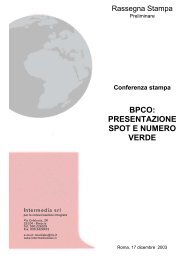
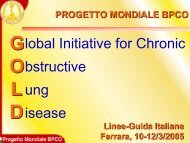
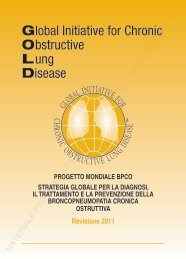
![Di Bari [NO].pdf - GOLD](https://img.yumpu.com/21544924/1/190x143/di-bari-nopdf-gold.jpg?quality=85)

